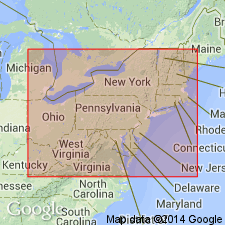
- Usage in publication:
-
- Lemon Fair Formation
- Modifications:
-
- Named
- Dominant lithology:
-
- Limestone
- Sandstone
- AAPG geologic province:
-
- New England province
Summary:
Lemon Fair Formation of /Bascom subgroup [informal] of Beekmantown Group. Includes "members 2 and 3 of Division D" of Brainerd and Seely (1890), which, according to authors, can not be separated on a regional basis. Consists of (ascending): drab and brown magnesian limestone with several beds of tough sandstone, 75 feet thick; and sandy limestone in thin beds with a few thin beds of pure limestone, 120 feet thick. Overlies Cutting Hill Formation [Cutting Formation of Cady (1945) redefined and renamed] and underlies Fort Cassin Formation. Age is Early Ordovician. Analysis of conodont assemblages indicates unit is part Demingian and part Cassinian while Jeffersonian stage missing.
Named from a river valley in west-central Vermont.
["Subgroup" not recognized as a formal stratigraphic rank term (CSN, 1933; ACSN, 1961, 1970; NACSN, 1983, 2005, 2021). Considered informal and should not be capitalized.]
Source: Modified from GNU records (USGS DDS-6; Reston GNULEX).
For more information, please contact Nancy Stamm, Geologic Names Committee Secretary.
Asterisk (*) indicates published by U.S. Geological Survey authors.
"No current usage" (†) implies that a name has been abandoned or has fallen into disuse. Former usage and, if known, replacement name given in parentheses ( ).
Slash (/) indicates name conflicts with nomenclatural guidelines (CSN, 1933; ACSN, 1961, 1970; NACSN, 1983, 2005, 2021). May be explained within brackets ([ ]).

